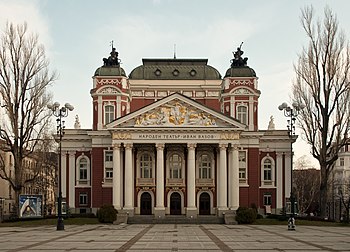Talk:Ivan Vazov National Theatre
| This article is rated Start-class on Wikipedia's content assessment scale. It is of interest to the following WikiProjects: | |||||||||||
| |||||||||||
National ?
[edit]National theatre is incorrect. Naroden translates as People's. I'm moving it. - ![]() Tourbillon A ? 07:49, 30 April 2009 (UTC)
Tourbillon A ? 07:49, 30 April 2009 (UTC)
- Please check what the predominant usage is before making such moves, and wait at least a few days so people can actually respond to your comments. Compare English ghits for Ivan Vazov National Theatre to those for Ivan Vazov People's Theatre. 5,750 vs 805. The best reference is the official website and the guys over there have it as "National Theatre" all the way. "People's" makes it sound as if it's some communist-era crap name, like People's Republic of Bulgaria, while the name is actually older and does not convey the meaning of "people's" as anything different from "national". Todor→Bozhinov 08:47, 30 April 2009 (UTC)
File:IvanVazov National Theatre 7.jpg to appear as POTD soon
[edit]Hello! This is a note to let the editors of this article know that File:IvanVazov National Theatre 7.jpg will be appearing as picture of the day on January 3, 2013. You can view and edit the POTD blurb at Template:POTD/2013-01-03. If this article needs any attention or maintenance, it would be preferable if that could be done before its appearance on the Main Page so Wikipedia doesn't look bad. :) Thanks! —howcheng {chat} 18:49, 1 November 2012 (UTC)
"Neoclassical" or Neo-Baroque"
[edit]
When is a "classicising" building, that is to say, one that employs a "classical" vocabulary with debts to Rome, not "Neoclassical", as the article has it, but "neo-Baroque?
- When its silhouette is dynamic and full of incident rather than unified and in repose.
- When its elements of massing are sculptural, "blocky" and three-dimensional, rather than flat ("planar").
- When its components penetrate one another, as the corner towers here penetrate the cornice, so that the outer bays of the front also read as the bases of the towers.
- When light-and-shade, projection and recession, are important effects.
- When clasps or sculpture connect window surrounds with entablatures so that no windows are isolated in the wall surface.
A close look at the the sculptured overdoors of the triple main entrances under the portico will convince the viewer that this building is baroque even in its details.--Wetman (talk) 01:21, 3 January 2013 (UTC)


